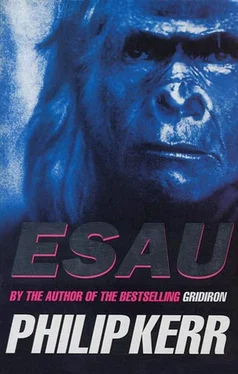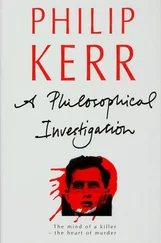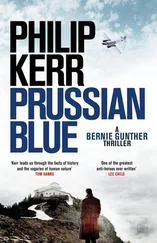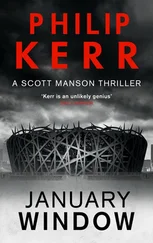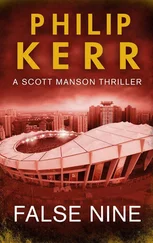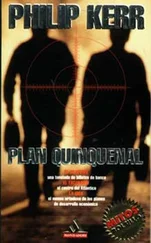Jack was one of the first out of the lodges to inspect the campsite for damage. The northern edge of the clamshell was buried in snow, as were several boxes of supplies too large to have gone down the shafts and into the lodges, but otherwise everything seemed to have survived intact. Jack took a deep, euphoric lungful of frost-chilled air, as if here, in one of the world’s most incredible glacier basins, life’s breath had a special sweetness for him.
To his left, forming the southern portal of the Sanctuary, was Hiunchuli; at six thousand four hundred metres, one of the smaller peaks of the Annapurna group. It was, he thought, a shapely looking mountain, reminding him most of the head and beak of some enormous bird of prey: Spindrift blew off the summit like a crest of snow-white feathers, and a sharp wing of an ice ridge curled toward Modi Peak, also known as Annapurna South.
Jack was still enjoying the air and the scenery when he heard a shout from further up the glacier basin, at the foot of the Hiunchuli ridge. Shielding his eyes against the blinding glare of the sun on the snow, for he was not yet wearing sunglasses. Jack saw a figure waving at him. Lifting the small Leica binoculars from the cord around his neck to his eyes, he saw a camera tripod and realized that the figure was MacDougall.
Jack waved back and started toward him.
An excited-looking Mac met Jack halfway, by then it was obvious to the American what it was that had so thrilled the small Scotsman: Leading down the otherwise pristine slope of the ice ridge, well beyond where Mac might have walked himself, and leading east around the campsite toward the Sanctuary’s exit, like a long black zipper, was a trail of footprints in the snow.
‘Has anyone else been out this morning? One of the Sherpas maybe?’
‘No, I was the first,’ insisted Mac. ‘I wanted to come out and catch the sun on film as it came up over the mountains. And there they were.’
They walked back toward the line of tracks.
‘For a moment I thought they were my own footprints, and then, when I saw how far up they went, I realized they couldn’t be.’
The two men stopped just short of the trail. Jack dropped down on one knee to take a closer look as Mac snatched the lens cap off his Nikon and began to fire off shots.
‘What do you think. Jack? It looks like it, doesn’t it?’
‘Could be, Mac.’
‘Isn’t it brilliant? I mean we’ve only just got here, and now this. It’s like winning the lottery on your first bloody go.’ He glanced at the f-stop on his camera and then at Jack. ‘Whatever it was came right over the ridge and virtually straight through our camp.’
‘Maybe Cody heard something last night after all.’
‘Yes, of course. I’d forgotten that.’ Mac shot some more film. ‘Thank Christ for all that snow. The whole Sanctuary’s like wet concrete. Just look at these tracks. They’re perfect. Couldn’t make a better picture if I’d styled and art-directed it myself.’
Jack lifted the GPS radio up from his chest and tilted his head toward the microphone. It was the sirdar who answered.
‘Hurké? What’s everyone doing right now?’
‘Breakfast, sahib.’
‘Well, tell them to finish their Cheerios and get their asses out here. And someone had better bring a tape measure. We’ve found some tracks. It looks like we almost had ourselves a visitor last night.’
Miles Jameson extended the tape measure across the length of one of the tracks in the snow, a tiny yellow metallic bridge over a pear-shaped crevasse.
‘Thirty five and a half centimetres long,’ he said to Swift, who was taking notes. Still holding the tape measure in place, he leaned back to let Mac take some detailed photographs for scale.
‘Brilliant,’ chuckled the Scotsman.
‘None of the porters would come and look,’ said Jutta. ‘Are they frightened, Tsering?’
‘Certainly, memsahib,’ said the assistant sirdar. ‘They are all rather superstitious, I’m afraid, and believe that to see a yeti or even hear one call signifies a bad omen. Do not be surprised if some foolish ceremony is now performed to ward off any bad luck.’ He shrugged apologetically. ‘Such is the character of my people.’
‘If they’re like this now,’ said Swift, ‘what will they be like if we’re lucky enough to capture a living specimen?’
‘American dollars can overcome any amount of potential bad luck,’ replied Tsering.
‘Now you’re talking,’ said Boyd.
Jameson probed the track with the tip of the tape measure and said, ‘Depth, about thirty-eight centimetres.’
He squinted inside the indentation like a golfer sizing up a putt, trying to determine a contour. Then he moved on to the next track and did the same.
‘It’s hard to get a clear view,’ he said.
Swift started to take notes again.
‘The snow has tumbled into each hole. But generally speaking, it’s a fairly long footprint with short toes and a longish big toe. Not as broad a footprint as I might have expected, but there are definitely no claw marks, and I’m one hundred percent certain that this is not a bear track. It’s hard to be more specific, but it certainly looks like some kind of higher anthropoid at any rate.’
There were several whoops of excitement. Mac punched the air in triumph. Jutta hugged Lincoln Warner.
‘What a great start,’ said Swift. ‘This is better than we could have hoped.’
‘These look exactly like Shipton’s photographs of the tracks he found on Everest’s Menlung Glacier,’ observed Mac. ‘For that matter, they’re the same as the ones Don Whillans photographed on Annapurna.’ He chuckled delightedly. ‘Christ, we’ve only just got here, eh?’
The sirdar squatted over the footprints for a moment, smoking thoughtfully.
‘Please, sahib,’ he said, flinging his cigarette away after a moment and holding his hand out to Miles Jameson. ‘May I take the Stanley Metro, please?’
Realizing that Hurké Gurung was talking about the tape measure, Jameson handed it over and watched him measure the distance between the footprints. Finally, the sirdar stood up and planted his own Berghaus boot in one track and then another.
‘Good King Wenceslas,’ joked Warner.
Gurung wobbled his head from side to side, as if uncertain about something, and said, ‘Maybe almost two metres. And not very heavy. I think pretty small yeti. Maybe not full-grown. Or maybe female.’
‘Do you hear that?’ Mac demanded triumphantly of Jon Boyd, who stood and watched the forensic examination of the tracks with an amused, detached interest. ‘The man said a yeti. Not a langur monkey. Not even the bloody Loch Ness monster. A yeti.’
‘If you say so, Mac,’ said Boyd. ‘But like you say, it’s still early.’
‘A young one or a female,’ Swift repeated.
‘Hajur, memsahib. It could be.’
‘We won’t know until we track it,’ said Jack.
‘The question is, which way?’ remarked Jameson.
‘How do you mean?’
‘The tracks lead from a source. Do we follow the animal, or do we trace the tracks back to the source?’
Jack followed Jameson’s eyes up the icy ridge connecting Hiunchuli with Annapurna South, from where the tracks had originated. The sky was still clear, but the gusts of wind carrying gossamer sails of spindrift snow were so strong that they seemed to promise yet more bad weather.
‘One is usually inclined to follow the tracks back to the source,’ said Jameson.
‘I figured on us all being here at ABC and becoming used to being above four thousand metres for a couple of days before we started going up any higher,’ said Jack. ‘It’s about twelve to fifteen hundred metres to the top of that ridge. Hard going if you’re not properly acclimatized.’ He shook his head. ‘Besides, the tracks lead toward Machhapuchhare and our major search area. So I guess that settles it. On this occasion, I think you’d better follow the animal. Swift, Hurké, Miles? The three of you had better get going before it snows again and you lose the trail.’
Читать дальше
